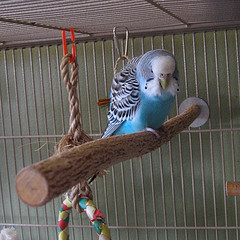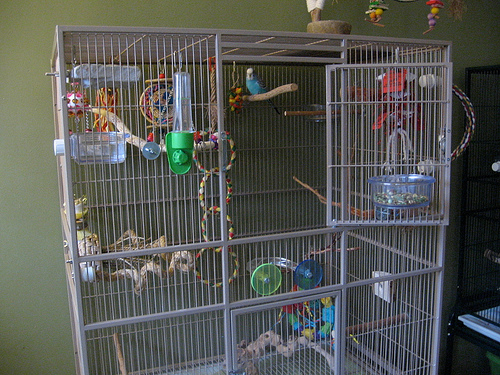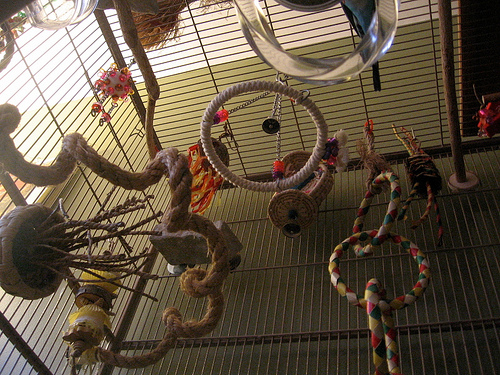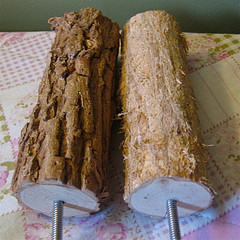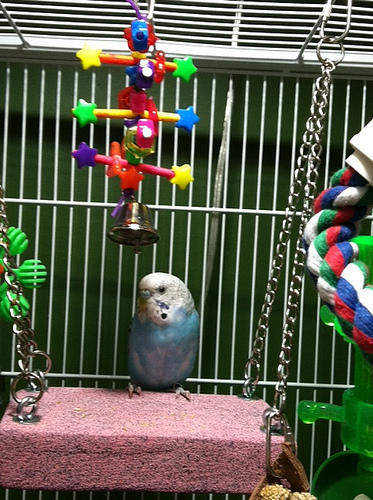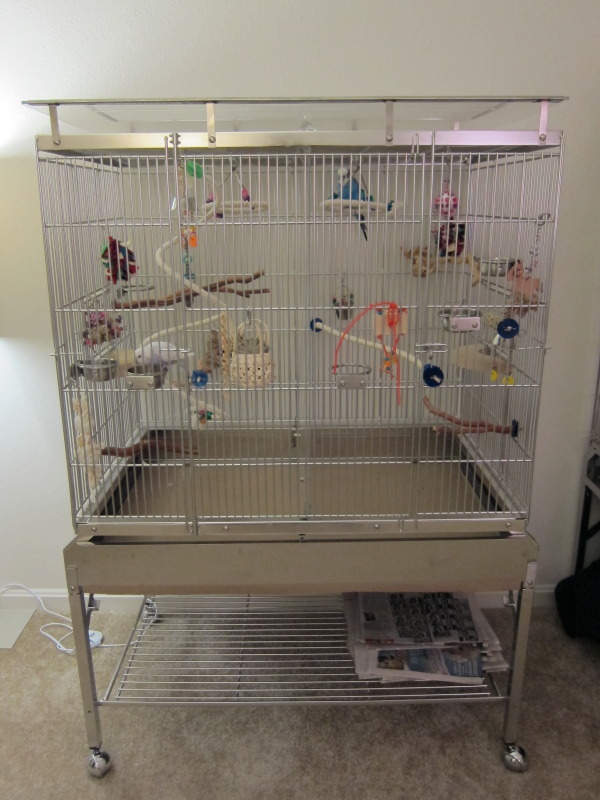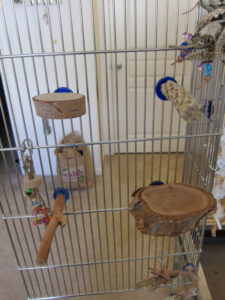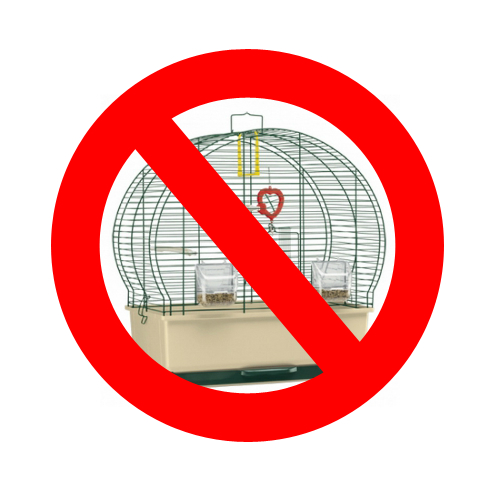
Budgerigars (a.k.a. “budgies”), often simply called “parakeets” in America, are one of the most popular species of pet birds. But most people don’t realize that budgies are actually little parrots.
And like all parrots, budgies are super smart and need mental and environmental enrichment, a great diet, appropriate toys, and lots of attention and playtime. Budgies are also very high energy, so should have lots of opportunity to move.
That means these small birds need big cages. It’s a big misconception that you can put small birds in tiny cages and that they’ll be ok. In fact, almost NONE of the cages they sell in typical pet stores are good enough to be daytime cages for ANY bird.
However, a cage can’t just be large, it must also be safe — and that means the bar spacing has to be appropriate for little beaks and bodies. The large parrot cages designed for cockatoos and African Greys feature spacing that’s too big (and therefore not safe) for smaller birds
Below are a few good examples of appropriately sized budgie cages, as well as tips for how to decorate your parakeets’ cage(s).
Pepper, Female Budgie, in Her Flight Cage
Lindsay has several small parrots, including Pepper a female budgie. When setting up budgie cages, Lindsay says she always focuses on two things: space to fly, and stuff to destroy!
Pepper has a spacious powder-coated flight cage, which not only is a great size, but also has appropriate bar spacing for parrots her size.
Lindsay stresses that it is incredibly important to her birds’ health and well-being to have room to exercise all day long, not just when they’re given out of cage time.
For that reason, when she sets up her birds’ cages, she leaves the center of the cage free of clutter, so that they have as much horizontal and diagonal flying space available as possible.
Lindsay explains that female budgies have strong beaks for their small size, “in the wild, they use their beaks to expand nesting cavities in trees – and I have found that nothing occupies my girls better than having natural materials to shred and chew.”
Right now, Pepper’s cage includes a number of ‘easy’ shredding toys, made of things like palm, seagrass, vine, paper, yucca (which are a HUGE hit), and balsa, as well as natural barky branches like bottlebrush that she can strip. In the spring and summer they really appreciate fresh leafy branches like hibiscus brought in from the yard for them to chew.
“I have also found that it is unnecessary to trim their toenails if they are provided with a variety of sizes of natural perches. I frequently buy larger than recommended perches as well as flat perches (they really like their flagstone perches) to supplement the small diameter ones that are advertised for budgies,” adds Lindsay.
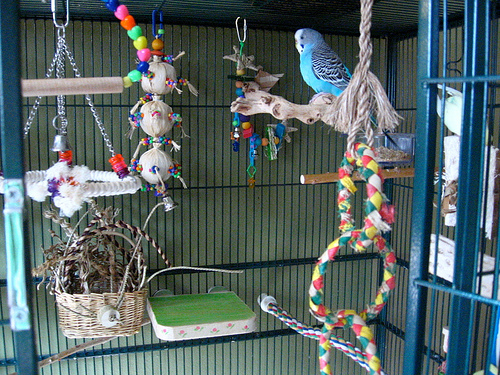
Pepper shares the bird room with six other birds: three cockatiels and two lineolated parakeets who are all cage optional during the day, as well as a small conure. Pepper can only be out of her flight cage when actively supervised because she tends to harass the other birds. “Keeping her safe around them is one of the most difficult things about my current set up (and has been a big lesson about the complications of keeping multiple species in one household),” says Lindsay.
Kristen’s 3 Boy Budgies Share a Flight Cage
Despite owning a number of parrot species, Kristen of PersnicketyParrot.com says budgies have always been her dream bird. So she was very excited upon bringing home three boy budgies recently.
Boo Boo, Turquey and Puff live together in a single flight cage and share a room (but not a cage) with a little parrotlet named Ziggy, who likes to come visit. Her other parrots, because of the size difference and potential for injury, live in a different room.
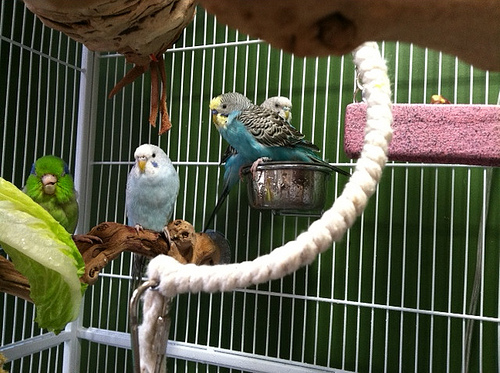
Kristen is a big fan of always offering several different types of wood perches. She always includes as much grapevine wood as she can because it is loved by all sizes of parrots for its varying textures and widths. The wood promotes healthy feet. In addition to wooden perches, she also includes at least one type of pedicure perch, at least one platform perch, and a comfy rope perch or two. A swing or two is also wonderful for exercise.
Similarly to how she includes different types of perches in her birds’ cages, Kristen also makes sure to include at least one toy in each category when she’s rotating out enrichment items: wood/chew toys, shredding toys, toys that provide exercise, and of course foraging toys appropriate for small birds. “You can never have too many foraging toys, and in fact, I prefer to feed my birds through foraging “stations” and toys in and out of their cages.”
In the wild, parrots, and especially budgies, forage throughout the day for their food. Foraging toys and foraging stations give birds a choice of what types of foods they’d like to eat at any given moment, and a new place to perch.
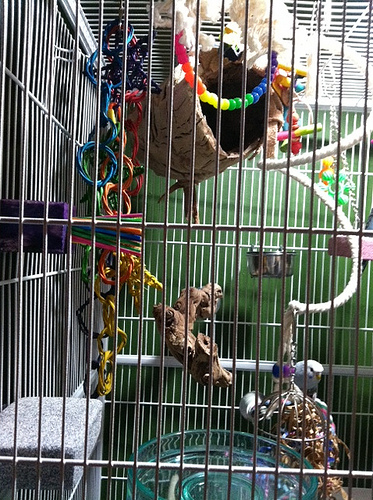
“These choices make for happier birds, in my opinion. After all, who would want to eat the same dry cereal each and every day? I offer my birds a choice in pellets, seed mixes, and many other types of fresh and cooked foods daily.
“Offering perches, toys, and foraging “stations” or toys at different heights and places around the cage gives your birds more room to exercise and explore. I utilize the entire cage offering food and water bowls, perches, foraging stations, and toys at all different levels.”
Kristen adds, “You don’t even have to have a dedicated foraging toy to provide foraging opportunities. In fact, you can utilize your cage bars and existing toys to string food through. I like to provide fresh veggies and fruits to my birds each morning. Sometimes it’s in the form of a CHOP mixture and sometimes I offer it hanging.” You can pierce delectable budgie treats on a small, stainless steel skewer and hang the skewer from other toys, for example. Be sure to keep these within easy reach if your parakeets are not flighted so they have easy access.
Kristen likes to provide her budgies a little bit of the outdoors in their cages as well, with bird-safe plants and UV lighting. “I purchased wheat grass at a local pet store — it’s “pet grass” — but you can grow your own grass and bird-safe plants and put them in terra cotta pots with organic coil in the bottom or tops of your cages for your parrots to enjoy. And don’t forget your lighting! I like to use the Featherbrite Cagetop Light Systems for my smaller birds’ cages.”
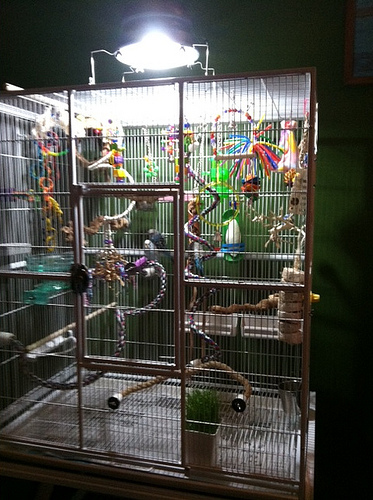
As you see, Kristen gives a lot of thought to how to enrich and entertain even her littlest parrots!
Sabrina and Charles in a Custom Expandable Habitats SS Cage
Sabrina and Charles are a female and male budgie belonging to Coco, who blogs extensively about the product choices she makes for her birds. In addition to being super conscientious about bird safety, Coco also takes particular care to find special products that will appeal to tiny birds.
When it comes to cages, she laments a fact that’s flummoxed everyone who’s ever wanted to buy the biggest cage possible for their small parrots: “It seems that well-made, functional, and large cages made for small birds (with 1/2″ bar spacing in particular) are quite the rarity.”
After investigating several options, Coco decided to go the route of ordering a custom-made cage for her budgies.
“I contacted a number of bird cage companies within the U.S.A., who make both powder-coated and stainless steel cages (and even aluminum, and at one point acrylic — not the acrylic sheet style but actually acrylic bars created in the same way as a traditional metal cage). Even with a relatively open-ended budget, I was turned down by a number of companies: making a large cage for a budgie, it seems, is actually much more difficult than it sounds. Some companies simply don’t work with small bars, as would be required for a bird as small as a budgie: the bars required for budgies are so much thinner than the thick bars used on a medium to large parrot cage, requiring far more support bars and therefore not only increasing cost but significantly increasing labor as well, and making the acceptable margin of error that much smaller. Eventually, I was literally left with only one: Expandable Habitats.”
Here are the specs the cage Coco ordered:
- an American-made cage
- 304-grade non-magnetic stainless steel
- 1/8″ bars spaced exactly 1/2″ apart
- Interior dimensions: 36″ wide by 24″ deep
- a large front door with one 6 x 6″ door on each side
- no grate, just a slide out tray
- an acrylic divider that keeps my aggressive two safe from each other
- a flat top with a frame that supports an acrylic sheet above
- a spacious shelf underneath
- the amazing paper roll system
- heavy duty casters
See detailed close-ups of the workmanship on her blog.
As for decorating and arranging perches and toys in Charles’ and Sabrina’s cage, Coco likes to switch things up every couple of weeks, but there are some general guidelines for where she places items.
Since the ‘keets are most likely to roost at the top parts of the cage, she ensures that those perches are the extra comfy kind.
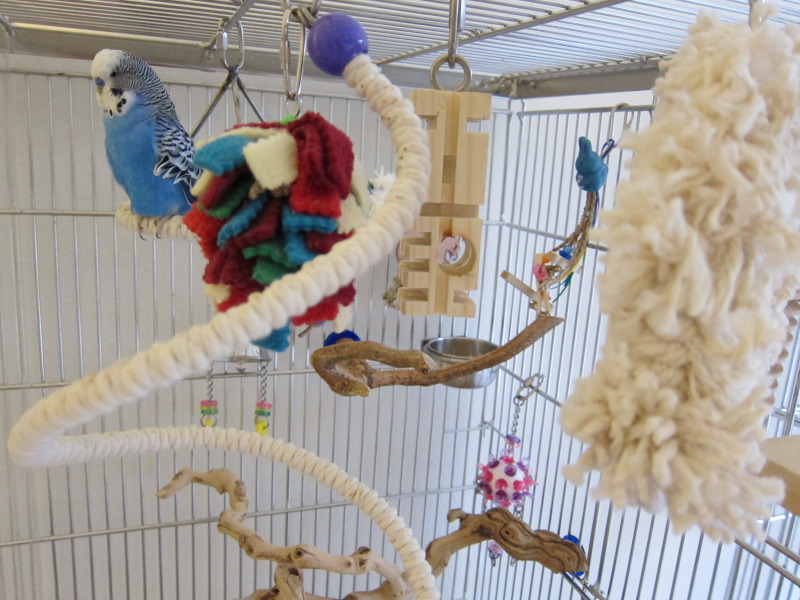
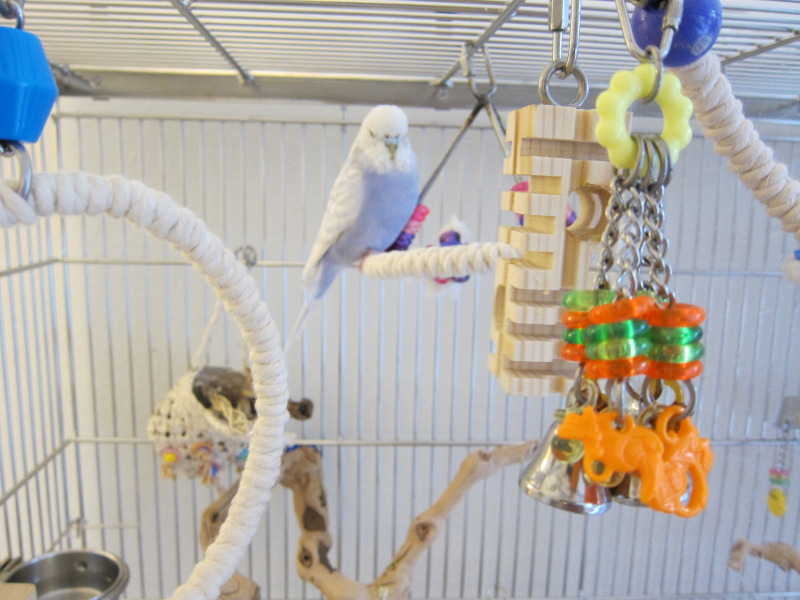
Charles (above) has tire-swing style perch for sleeping, a boing, and another cotton rope fluffy swing. His toys include a fleece puff, a leather horse, a bunny with seagrass and beads, and a Puzzler Foraging block.
Sabrina has her own budgie-sized “Puzzler Foraging Block” and a noisy bell that she loves to ring when she’s playing on her boing, as well as a grapevine perch you can see at the bottom of the picture.
(You can read much, much more about the various toys that Coco meticulously selects for her little ones by visiting her site here.)
Complementing a variety of rope perches and boings are various wood perches of varying textures and hardness. Below is another view of the different kinds of perches that are safe and appropriate little ‘keets and similar parrots.
At night, when it’s time to sleep, Coco covers Charles and Sabrina’s cage with a custom cage cover made of “heavy, high-quality fabric, [that is] completely lined with a heavy sateen that keeps all the light out.” Because after a full day of playing in their cages, these little birds like to get a good night’s rest!
Looking for More Cage Examples?
Have a bigger bird and looking for other cage setup ideas? Check out these related posts:
- African Grey Cage Setups
- Finch Cage Setup Ideas
- Cape Parrot Cages
- Cockatoo Cage Setup Examples
- Pionus Cage Setup Ideas
- Conure Cage Examples
Photos used by permission. Thanks to Lindsay for photos of Pepper’s cage, Coco for sharing all her wonderful information about what Charles and Sabrina like, and Kristen of Persnickety Parrot for her photos of Boo Boo, Turquey and Puff.
For additional information about getting a new cage, see our tips for choosing a good parrot cage, as well as minimum cage size requirements for parrot species.
